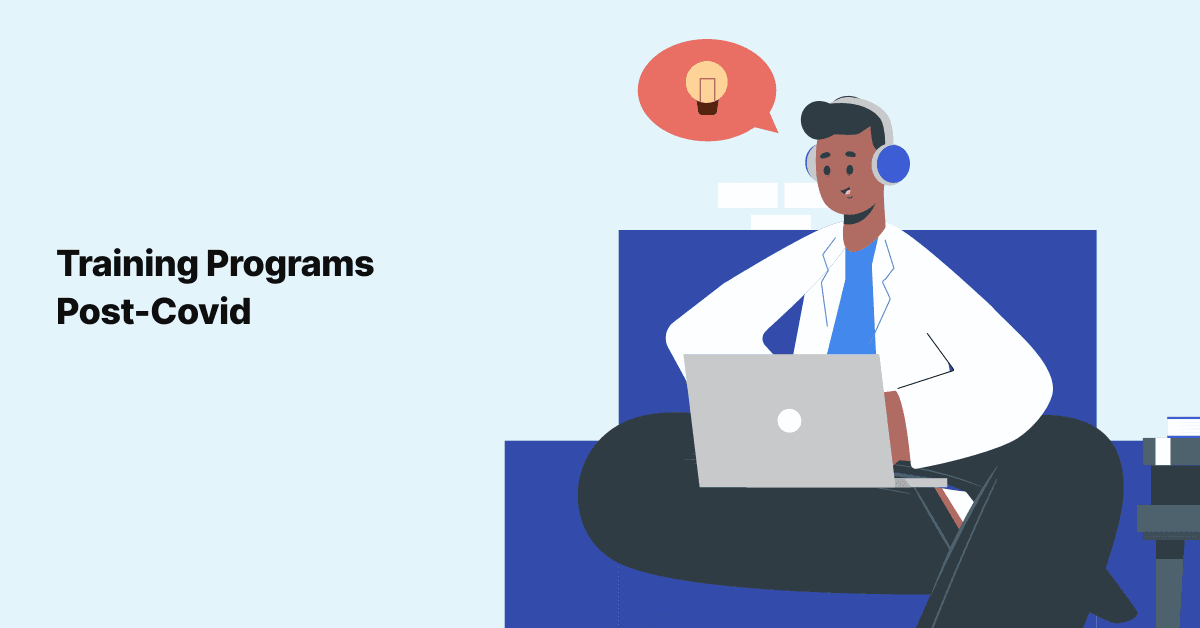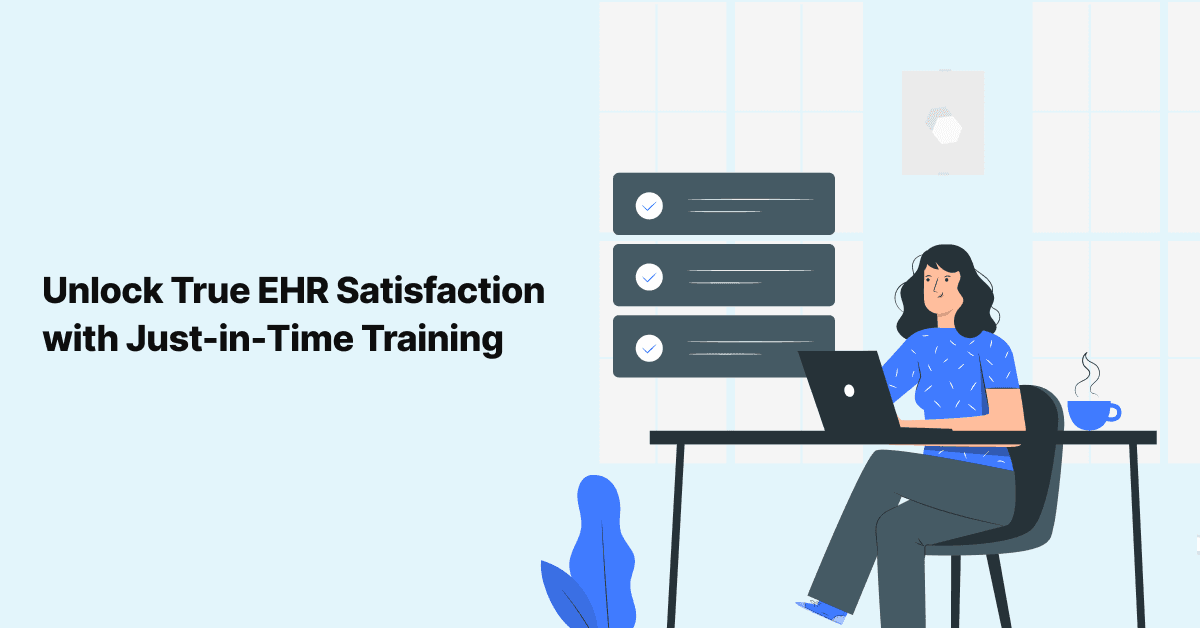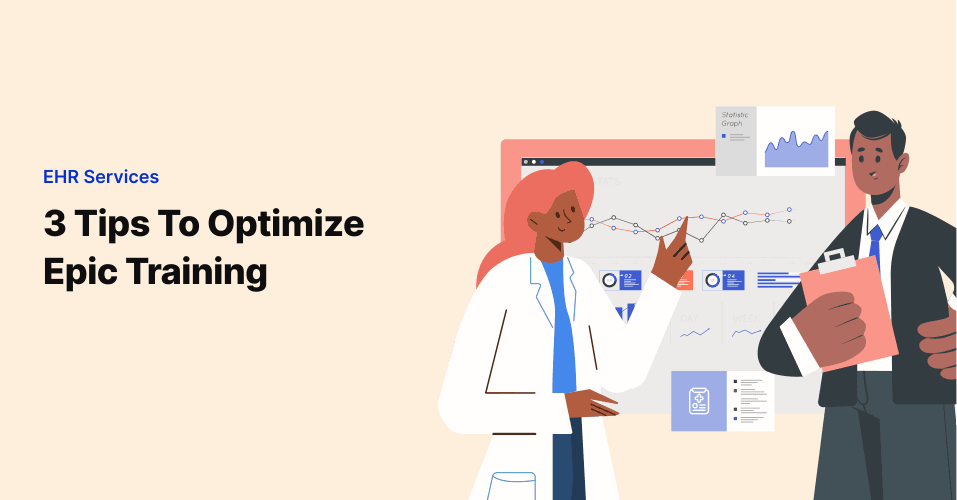
Learners are returning. Are you ready?
As you read this blog, many restrictions put in place due to Covid-19 are being relaxed. The travel …

If you're a leader in a hospital or health system, the conversation around your Electronic Health Record (EHR) system is likely a recurring source of tension. The complaints are a familiar refrain: “It’s clunky,” “It’s slow,” “I spend more time clicking boxes than I do with my patients.” For years, the industry has pointed to two primary culprits for this widespread frustration: the EHR software itself or the need to simplify existing clinical workflows. But what if there’s a third, often-overlooked factor that holds even more sway over success or failure? What if the real problem isn’t just the technology or the process, but how we prepare our people to master them?
We invest millions in these sophisticated systems, yet we often default to a decades-old training model: a one-and-one, eight-hour classroom session that crams an encyclopedia of information into a single day. We hand our brilliant, highly-trained clinicians the keys to a digital cockpit and expect them to fly it flawlessly after a brief lecture. As data from the KLAS Arch Collaborative report, "EHR MASTERY: THE IMPACT OF TRAINING," reveals, this variance in user experience often has little to do with the technology itself. In fact, KLAS found instances where physicians in the same specialty, using the same EHR, held polar opposite views on its quality, proving the variance is in the users, not the system.
This article isn't another critique of EHRs. It is a persuasive argument for a new way forward. We will explore the staggering, often hidden costs of low EHR satisfaction, dismantle the myths of traditional training, and introduce a modern, effective solution that is changing the game for healthcare organizations: Just-in-Time Training. It’s time to shift the conversation from frustration to empowerment and unlock the true potential of both your technology and your people.
What this blog covers:
For CIOs, CMIOs, and informatics leaders, EHR satisfaction is not a soft metric or a "nice-to-have." It is a critical key performance indicator with a direct, measurable impact on your organization's financial health, operational stability, and clinical excellence. The biggest drivers of EHR dissatisfaction are consistently poor usability, slow system performance, excessive data entry requirements, and overwhelming alert fatigue. But as the data shows, the lynchpin holding it all together is inadequate training, which prevents clinicians from learning efficient workflows and makes the entire system feel more burdensome. Ignoring this is no longer an option because the consequences are proving to be devastating.
Let's be blunt: your clinicians are exhausted. According to industry research, over one-third of physicians experience burnout, and more than half of them point directly to their EHR as a primary cause. When a tool designed to support care becomes a source of daily friction, it increases cognitive load and chips away at professional fulfillment. The Arch Collaborative’s report, "EHR MASTERY: THE IMPACT OF TRAINING," found that the quality of a provider's initial EHR education is the single biggest predictor of their satisfaction, accounting for 50% of the variation in their experience. When we fail at training, we are actively contributing to the burnout crisis.
The most critical cost of poor EHR adoption is the one that impacts patients. When clinicians are overwhelmed by a tsunami of notifications, they develop "alert fatigue." This cognitive overload can lead them to ignore or override critical warnings, contributing to a documented increase in medical errors. Furthermore, every minute a doctor or nurse spends fighting with a clumsy interface is a minute they are missing on clinical reasoning, patient communication, or compassionate care. Low EHR satisfaction isn't just an IT problem; it's a patient safety crisis in the making.
For decades, the default approach to EHR education has been standardized, classroom-based training. We herd new hires into a room for a full day, bombard them with information, and hope for the best. The data clearly shows this model is fundamentally broken. According to the KLAS report, organizations that provide less than two hours of initial training see significantly lower satisfaction scores than those that offer more. But even extending that classroom time has its limits.
Have you ever crammed for an exam, only to forget most of it a week later? That’s the Ebbinghaus forgetting curve in action, and it’s exactly what happens after a typical EHR training day. Humans can forget up to 90% of what they learn within a month if the knowledge isn't reinforced. Handing a surgeon a 200-page manual and providing a single 8-hour session on a system they may not use for another week is an exercise in futility. This 'leaky bucket' phenomenon means a huge portion of your initial training investment disappears almost immediately, a problem we explored in detail when discussing why your biggest EHR training investment is disappearing. In short, the knowledge simply doesn't stick because it's delivered out of context and long before the moment of need.
Imagine trying to learn a new language by reading the entire dictionary in one sitting. It’s impossible. That's what traditional EHR training feels like to a clinician. These sessions are often generic, trying to be everything to everyone. They cover hundreds of functions, from placing a simple order to navigating complex regulatory documentation, most of which may not be relevant to a specific user's daily workflow. This information overload leads to cognitive fatigue, and clinicians walk away remembering only a fraction of what they were taught, often defaulting to inefficient workarounds they learn from colleagues later.
A pediatrician's workflow for a wellness check is vastly different from a cardiologist's workflow for an EKG interpretation or an oncologist's for a chemotherapy order set. A generic, one-size-fits-all training curriculum cannot possibly address these unique, specialty-specific needs. This forces specialists to either ignore advanced features designed for them or struggle to adapt generic processes to their complex worlds, leading to immense frustration and a feeling that the EHR is working against them, not for them.
If the old model is broken, what does a better one look like? The answer lies in shifting our entire mindset from training as a one-time event to learning as a continuous, integrated process. The most effective way to improve EHR training is to move beyond the classroom and embrace this modern approach. This is the promise of Just-in-Time Training.
At its core, Just-in-Time Training is a simple but powerful concept: deliver the right information to the right person, at the exact moment they need it, directly within their workflow. It's not about memorizing hundreds of functions. It's about providing immediate, contextual guidance to complete the task at hand efficiently and accurately. Think of it less like a textbook and more like a GPS navigation system for your EHR. You don’t need to know the entire map; you just need to know the next turn to take.
For a deeper dive into this transformative strategy, explore The Ultimate Guide to Just-in-Time Training for Healthcare Leaders.
Just-in-Time learning abandons the classroom and moves education to the front lines of patient care. A physician struggling to find a specific order set doesn't have to stop, search for a tip sheet on SharePoint, or call the help desk and wait on hold. Instead, they get a small, pop-up guide right on their EHR screen that walks them through the exact steps in seconds. This in-workflow support respects the clinician's time, reduces frustration, and reinforces correct usage in a real-world context, dramatically improving knowledge retention.
The gold standard for Just-in-Time support has always been "at-the-elbow" training, where an expert physically stands beside a clinician to offer guidance. While incredibly effective, it's also incredibly expensive and difficult to scale, especially for large health systems with round-the-clock needs. Today, technology has bridged that gap. Modern Just-in-Time Training platforms deliver this personalized support digitally, offering scalable, on-demand microlearning that can be customized for any workflow or specialty. This provides the benefits of personalized coaching without the logistical and financial constraints.
Adopting a Just-in-Time Training model isn't just about making clinicians happier; it's a strategic move that delivers tangible returns across the organization. By empowering users with the right knowledge at the right time, you unlock a cascade of positive outcomes.
Instead of overwhelming users with hours of content, Just-in-Time Training platforms deliver information in small, digestible "microlearning" bites. These might be 90-second videos or simple tip sheets that are easy to consume and apply immediately. This approach builds user confidence, reduces the fear of "doing it wrong," and encourages clinicians to explore and master their EHR, rather than just surviving it.
A well-designed Just-in-Time Training system can proactively guide users through complex workflows, ensuring they follow the most efficient path. This reduces the mental effort, or cognitive load, required to navigate the EHR. Furthermore, by teaching clinicians how to properly manage their preferences and respond to alerts, this training can help tame the constant barrage of notifications, reducing alert fatigue and allowing them to focus on the signals that truly matter for patient safety.
In today's dynamic healthcare environment, bringing new hires, locum tenens, and traveling nurses up to speed quickly is a competitive advantage. A Just-in-Time Training platform is an invaluable asset for onboarding, providing a consistent, self-service resource that new users can rely on from day one. This drastically reduces the time it takes for them to become proficient and productive, easing the burden on preceptors and IT staff.
Your EHR is packed with powerful features designed to save time and improve care, but many of them go unused because clinicians were never properly trained on them or have forgotten they exist. Just-in-Time Training can help promote the use of these capabilities through timely, strategized training, driving deeper, more meaningful adoption of your technology investment.
Transitioning to a modern training model requires more than just buying new software. It demands a strategic, thoughtful approach to change management. As a leader, your role is to champion this shift and guide your organization through the process. A Just-in-Time Training platform doesn't replace your training team; it empowers them. It frees your trainers from endlessly repeating basic instructions and allows them to focus on higher-value activities like performance consulting and strategic interventions.
Before you can implement a solution, you must deeply understand the problem. Go beyond anecdotal complaints. Deploy targeted surveys, conduct workflow analyses, and shadow clinicians to identify the specific tasks and workflows that cause the most friction. Use your EHR's backend data to see where users are making errors or taking too long. This data-driven assessment will give you a clear map of where Just-in-Time support will have the most immediate impact.
Not all digital training platforms are created equal. Find a partner who deeply integrates with your EHR, using its native APIs to provide a seamless, in-workflow experience rather than a clunky overlay. In today's landscape, it's crucial to select a platform that leverages modern technology, including Artificial Intelligence (AI), to personalize learning paths and proactively identify users who are struggling. The platform should be easy for your informatics or training team to customize with your specific workflows and content. Crucially, it must provide robust analytics so you can track user engagement, measure proficiency gains, and demonstrate a clear return on investment.
Implementing Just-in-Time technology is the first step; creating a culture that embraces it is the goal. This means moving away from the perception of training as a punitive measure for those who "don't get it." Instead, frame it as a tool for empowerment and professional development. According to the KLAS report "Easy Lifts for Quickly Improving EHR Satisfaction," some organizations achieve this by embedding clinician wellness into their culture and fostering mutual support. Celebrate clinicians who master new skills and share success stories. Make ongoing EHR training and continuous learning a core value of your organization.
The beauty of a modern training strategy is that its success is measurable. Clinician EHR satisfaction is typically measured through a combination of methods. Standardized national surveys, like those from the KLAS Arch Collaborative, provide benchmarking against peer organizations. Internally, health systems use pulse surveys, direct feedback forums, and usability testing. By tracking the right metrics, you can clearly demonstrate its value to your executive board and your frontline staff.
Look beyond simple satisfaction scores. Track concrete operational metrics that prove the platform is working. These should include:
Leverage national benchmarks like the Arch Collaborative, which represents nearly 300 healthcare organizations and over 440,000 clinician responses, to see how your scores stack up. Combining this external data with internal pulse surveys before and after your Just-in-Time Training implementation will create a powerful narrative of improvement. This allows you to set realistic goals and celebrate wins as you progress.
Ultimately, the goal of improving EHR satisfaction is to improve the lives of your clinicians. The most meaningful metric of success is a quantifiable reduction in burnout symptoms. As highlighted in the KLAS "Easy Lifts" report, leading organizations have used a combination of better training and support to achieve rankings in the 89th percentile for providers reporting no symptoms of burnout. When your clinicians report a better work-life balance and renewed joy in their work, you know your strategy has truly succeeded.
The beauty of a modern training strategy is that its success is measurable. Clinician EHR satisfaction is typically measured through a combination of methods. Standardized national surveys, like those from the KLAS Arch Collaborative, provide benchmarking against peer organizations. Internally, health systems use pulse surveys, direct feedback forums, and usability testing. By tracking the right metrics, you can clearly demonstrate its value to your executive board and your frontline staff.
Look beyond simple satisfaction scores. Track concrete operational metrics that prove the platform is working. These should include:
Leverage national benchmarks like the Arch Collaborative, which represents nearly 300 healthcare organizations and over 440,000 clinician responses, to see how your scores stack up. Combining this external data with internal pulse surveys before and after your Just-in-Time Training implementation will create a powerful narrative of improvement. This allows you to set realistic goals and celebrate wins as you progress.
Ultimately, the goal of improving EHR satisfaction is to improve the lives of your clinicians. The most meaningful metric of success is a quantifiable reduction in burnout symptoms. As highlighted in the KLAS "Easy Lifts" report, leading organizations have used a combination of better training and support to achieve rankings in the 89th percentile for providers reporting no symptoms of burnout. When your clinicians report a better work-life balance and renewed joy in their work, you know your strategy has truly succeeded.
Join over 3,200 subscribers and keep up-to-date with the latest innovations & best practices in Healthcare IT.

As you read this blog, many restrictions put in place due to Covid-19 are being relaxed. The travel …

Given the breadth and depth of information required to successfully train clinical staff on an EHR, it’s …

The implementation of an EHR is certainly a breakthrough for your health system; however, clinicians are still …